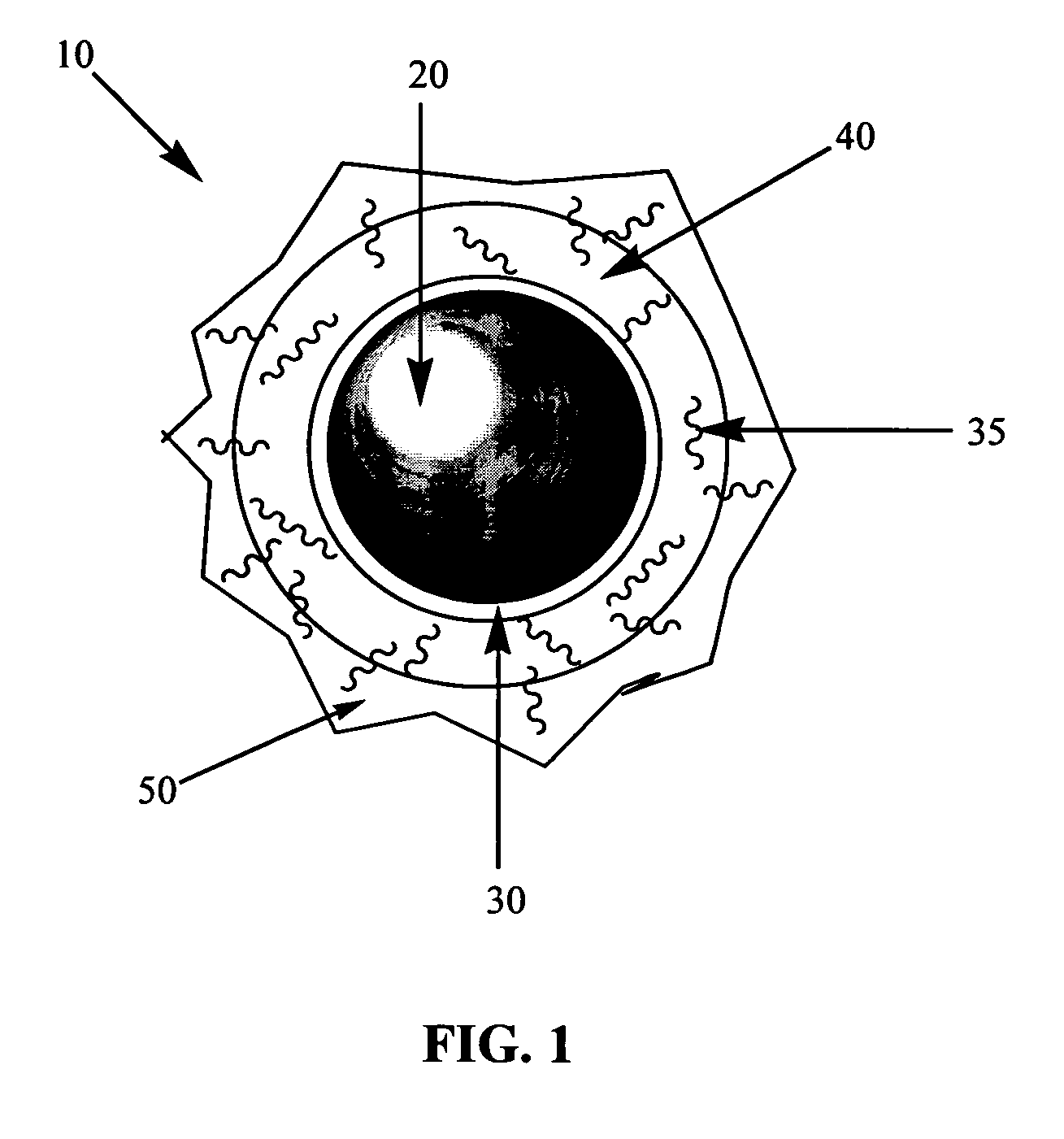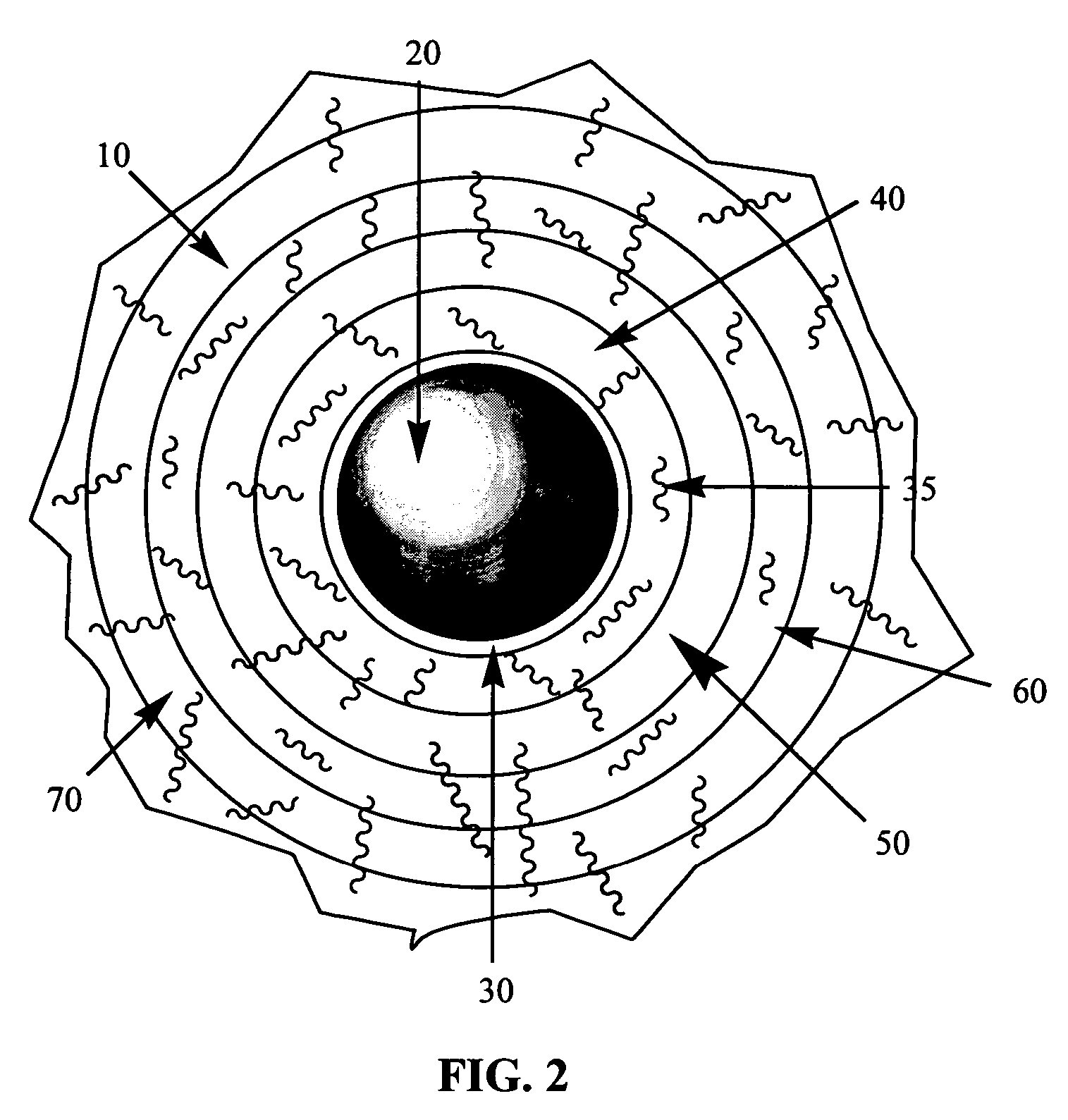Soluble fibers for use in resin coated proppant
a technology of resin coating and soluble fibers, which is applied in the direction of synthetic resin layered products, natural mineral layered products, borehole/well accessories, etc., can solve the problems of insufficient addressing of the propping agent, the insoluble fibers are described rough, and the fluid flow is improved
- Summary
- Abstract
- Description
- Claims
- Application Information
AI Technical Summary
Benefits of technology
Problems solved by technology
Method used
Image
Examples
example 1
Preparation of Resin Coated Particulate Having Soluble Fibers
[0073]The coating process was as follows for the inventive product, at the laboratory scale:[0074]1) 30 lbs of the processed particulate substrate (sand, ceramic, bauxite, etc.) was charged to a rotary drum heater and heated to a temperature of 400° F. (204° C.) to 450° F. (232° C.).[0075]2) The heated ceramic was charged to a 1500 lb capacity Barber Green batch muller (mixer).[0076]3) 182 grams of phenolic Novolak resin was added to the mixer containing the particulate substrate (sand), and the resin allowed to melt, coat, and mull for 40 seconds.[0077]4) 18 grams of soluble fibrous material (Polyox, WSR80 from Dow Chemical Co., Freeport, Tex.) was then added to the mixer and allowed to mull for approximately 10 seconds.[0078]5) At this point, 63.7 grams of a 40% (wt) aqueous hexamethylenetetramine solution was added.[0079]6) Immediately thereafter, 182 grams of phenolic novolak resin was added.[0080]7) A further 18 grams...
example 2
Settling Rate Tests
[0085]Settling tests were performed according to industry standards. In a typical procedure, a 500-mL graduated cylinder was filled with a 2% aqueous KCl solution, up to the 500-mL graduation mark. The height of the solution column was then recorded. A single particle of each of the products (conventional resin-coated proppant, or the resin-coated proppant in accordance with the present invention) was then dropped into the solution, and the settling time was recorded. Tests were repeated 6 times for each sample, and were carried out at both room temperature (˜25° C.) and at 150° F. (65.6° C.). These results are shown in Tables 1 and 2 be
[0086]
TABLE 1Settling Rate test results at room temperature (25° C.).Conventional RCP1Experimental RCPTest RunRate (ft / min)Rate (ft / min)132.6525.26233.5622.43329.6326.22433.5624.61530.3725.82635.8226.911RCP = “Resin-coated proppant”
[0087]
TABLE 2Settling Rate test results at 150° F. (65.6° C.).Conventional RCPExperimental RCPTest Ru...
example 3
Flowback Rate Tests
[0088]Flowback rate tests were performed according to industry standards. In a typical procedure, forty-gram samples of a particular particle size of the material prepared in Example 1 were isoated and used in a test cell. Comparisons were made between the proppant of the present invention, containing soluble fibers (EXP), and both procured resin coated proppants and curable resin coated proppants. The results are shown in Tables 3 and 4 below.
[0089]
TABLE 3Flowback test results of a pre-cured resin coated product (TLC) vs.soluble fiber resin coated proppant of the invention (TLC EXP).20 / 40 TLC20 / 40 TLC EXPFlowbackFlowback cum.cum. (grams)(grams)Stress (psi)1Stress cycle003000110001.5103000210002.5203000310003.52.50.83000410004.5003000510005.52.813000610006.5102.13000710007.5123.43000810008.5153.83000910009.52043000101Stress is given in 1,000 to 3,000 psi cycles.
[0090]
TABLE 4Flowback test results of a curable resin coated product (SLC) vs.soluble fiber resin coated...
PUM
| Property | Measurement | Unit |
|---|---|---|
| softening point | aaaaa | aaaaa |
| concentrations | aaaaa | aaaaa |
| concentrations | aaaaa | aaaaa |
Abstract
Description
Claims
Application Information
 Login to View More
Login to View More - R&D
- Intellectual Property
- Life Sciences
- Materials
- Tech Scout
- Unparalleled Data Quality
- Higher Quality Content
- 60% Fewer Hallucinations
Browse by: Latest US Patents, China's latest patents, Technical Efficacy Thesaurus, Application Domain, Technology Topic, Popular Technical Reports.
© 2025 PatSnap. All rights reserved.Legal|Privacy policy|Modern Slavery Act Transparency Statement|Sitemap|About US| Contact US: help@patsnap.com


